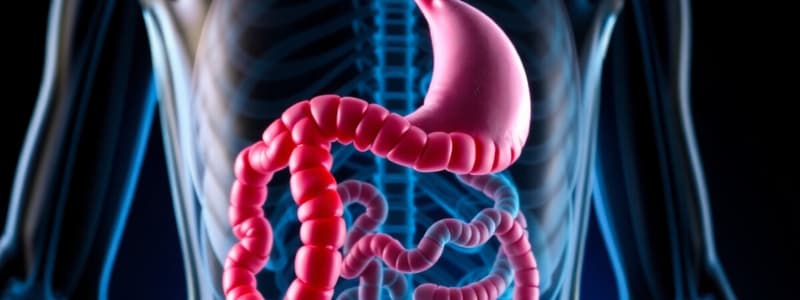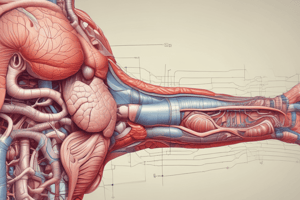Podcast
Questions and Answers
What type of digestion does the mouth carry out?
What type of digestion does the mouth carry out?
Mechanical and chemical digestion
Which enzyme is responsible for breaking down starch?
Which enzyme is responsible for breaking down starch?
- Nuclease
- Lipase
- Protease
- Amylase (correct)
The stomach primarily absorbs nutrients into the bloodstream.
The stomach primarily absorbs nutrients into the bloodstream.
False (B)
What does the large intestine absorb?
What does the large intestine absorb?
What is the function of bile?
What is the function of bile?
The breakdown of fats into ______ and glycerol is carried out by lipase.
The breakdown of fats into ______ and glycerol is carried out by lipase.
Which of the following enzymes is involved in the breakdown of proteins?
Which of the following enzymes is involved in the breakdown of proteins?
Which of these is NOT a monosaccharide?
Which of these is NOT a monosaccharide?
Cellulose, a type of fiber, is easily digested by human enzymes.
Cellulose, a type of fiber, is easily digested by human enzymes.
What are the two primary sites where protein digestion occurs?
What are the two primary sites where protein digestion occurs?
What process breaks down food into smaller absorbable molecules?
What process breaks down food into smaller absorbable molecules?
Lying down immediately after swallowing pills can improve absorption.
Lying down immediately after swallowing pills can improve absorption.
What is the primary function of the cuticle in a leaf?
What is the primary function of the cuticle in a leaf?
Match the following leaf structures with their functions:
Match the following leaf structures with their functions:
Which organ is primarily responsible for the emulsification of fats during digestion?
Which organ is primarily responsible for the emulsification of fats during digestion?
What is the role of villi in the small intestine?
What is the role of villi in the small intestine?
Which enzyme breaks down lactose into glucose and galactose?
Which enzyme breaks down lactose into glucose and galactose?
What substance is produced by the pancreas to neutralize stomach acid?
What substance is produced by the pancreas to neutralize stomach acid?
What type of digestion is primarily achieved in the stomach?
What type of digestion is primarily achieved in the stomach?
Which statement about cellulose is true?
Which statement about cellulose is true?
What is the primary role of the large intestine?
What is the primary role of the large intestine?
How does body position influence pill intake?
How does body position influence pill intake?
What is the primary function of the stomata in leaves?
What is the primary function of the stomata in leaves?
In which part of the chloroplast do light-dependent reactions occur?
In which part of the chloroplast do light-dependent reactions occur?
Which colors of light are primarily absorbed by plants during photosynthesis?
Which colors of light are primarily absorbed by plants during photosynthesis?
What is produced during the light-dependent reactions of photosynthesis?
What is produced during the light-dependent reactions of photosynthesis?
What is the main role of the mesophyll in a leaf?
What is the main role of the mesophyll in a leaf?
What happens to stomata in dry environments?
What happens to stomata in dry environments?
Which process converts CO₂ into glucose in photosynthesis?
Which process converts CO₂ into glucose in photosynthesis?
What is the equation for photosynthesis?
What is the equation for photosynthesis?
Flashcards
Digestion in Mouth
Digestion in Mouth
Mechanical and chemical digestion begins in the mouth, with chewing breaking down food and saliva containing amylase starting starch breakdown.
Stomach's Role in Digestion
Stomach's Role in Digestion
The stomach produces gastric juices (acid and pepsin) to churn and break down proteins.
Small Intestine's Role
Small Intestine's Role
Small intestine is major digestion and absorption site. Enzymes break down carbs, proteins, and fats releasing nutrients into the blood.
Large Intestine Function
Large Intestine Function
Signup and view all the flashcards
Pancreas in Digestion
Pancreas in Digestion
Signup and view all the flashcards
Liver's Role in Digestion
Liver's Role in Digestion
Signup and view all the flashcards
Gallbladder's Function
Gallbladder's Function
Signup and view all the flashcards
Amylase Enzyme
Amylase Enzyme
Signup and view all the flashcards
Protease Enzyme
Protease Enzyme
Signup and view all the flashcards
Lipase Enzyme Function
Lipase Enzyme Function
Signup and view all the flashcards
Carbohydrate Breakdown
Carbohydrate Breakdown
Signup and view all the flashcards
Protein Breakdown
Protein Breakdown
Signup and view all the flashcards
Lipid Breakdown
Lipid Breakdown
Signup and view all the flashcards
Cellulose Role
Cellulose Role
Signup and view all the flashcards
Photosynthesis Equation
Photosynthesis Equation
Signup and view all the flashcards
Light-Dependent Reactions
Light-Dependent Reactions
Signup and view all the flashcards
Light-Independent Reactions
Light-Independent Reactions
Signup and view all the flashcards
Chloroplast Structure
Chloroplast Structure
Signup and view all the flashcards
Stomata Adaptation
Stomata Adaptation
Signup and view all the flashcards
Aerobic Respiration
Aerobic Respiration
Signup and view all the flashcards
Anaerobic Respiration
Anaerobic Respiration
Signup and view all the flashcards
Mitochondria Structure
Mitochondria Structure
Signup and view all the flashcards
Energy Transfer in Food Webs
Energy Transfer in Food Webs
Signup and view all the flashcards
Autotroph
Autotroph
Signup and view all the flashcards
Heterotroph
Heterotroph
Signup and view all the flashcards
Carbon Cycle
Carbon Cycle
Signup and view all the flashcards
Nitrogen Cycle
Nitrogen Cycle
Signup and view all the flashcards
Water Cycle
Water Cycle
Signup and view all the flashcards
Phosphorus Cycle
Phosphorus Cycle
Signup and view all the flashcards
What does amylase break down?
What does amylase break down?
Signup and view all the flashcards
Peristalsis
Peristalsis
Signup and view all the flashcards
What happens in the small intestine?
What happens in the small intestine?
Signup and view all the flashcards
Role of the liver in digestion
Role of the liver in digestion
Signup and view all the flashcards
What does pepsin do?
What does pepsin do?
Signup and view all the flashcards
Why is fiber important?
Why is fiber important?
Signup and view all the flashcards
What is chyme?
What is chyme?
Signup and view all the flashcards
What does the pancreas produce?
What does the pancreas produce?
Signup and view all the flashcards
What is the cuticle's function?
What is the cuticle's function?
Signup and view all the flashcards
What is the role of stomata?
What is the role of stomata?
Signup and view all the flashcards
What happens in the mesophyll?
What happens in the mesophyll?
Signup and view all the flashcards
How does light affect plants?
How does light affect plants?
Signup and view all the flashcards
What's the equation for photosynthesis?
What's the equation for photosynthesis?
Signup and view all the flashcards
What are light-dependent reactions?
What are light-dependent reactions?
Signup and view all the flashcards
What happens in the Calvin Cycle?
What happens in the Calvin Cycle?
Signup and view all the flashcards
Where are light-dependent and light-independent reactions located?
Where are light-dependent and light-independent reactions located?
Signup and view all the flashcards
Study Notes
Digestive System
- Mouth: Chewing and saliva with amylase to break down starch
- Stomach: Stomach acid and enzymes like pepsin break down proteins, churning food into chyme
- Small Intestine: Main site of digestion and absorption; enzymes (amylase, protease, lipase) break down carbs, proteins, and fats respectively; nutrients absorbed via villi into bloodstream
- Large Intestine: Absorbs water and electrolytes, forming and storing feces
- Pancreas: Produces digestive enzymes (amylase, lipase, protease) and bicarbonate to neutralize stomach acid
- Liver: Produces bile to emulsify fats for digestion in small intestine
- Gallbladder: Stores bile, releasing it into the small intestine for fat digestion
- Rectum and Anus: Store and expel waste
Enzymes Involved in Digestion
- Amylase: Breaks down starch into sugars (active in mouth and small intestine)
- Protease (e.g., Pepsin): Breaks down proteins into amino acids (active in stomach)
- Lipase: Breaks down fats into fatty acids and glycerol (active in small intestine)
- Lactase: Breaks down lactose into glucose and galactose (active in small intestine)
- Nuclease: Breaks down nucleic acids into nucleotides (active in small intestine)
Digestion of Different Molecules
- Carbohydrates: Broken down by amylase (mouth) and other enzymes (small intestine) into monosaccharides (e.g., glucose)
- Cellulose/Fiber: Not digested by human enzymes; adds bulk to stool and aids peristalsis
- Proteins: Broken down by proteases (stomach - pepsin, small intestine - trypsin and chymotrypsin) into amino acids
- Lipids: Broken down by lipase (small intestine) into fatty acids and glycerol
Body Position and Pill Intake
- Body position affects pill intake and absorption
- Swallowing pills while sitting upright ensures they pass through the esophagus and stomach efficiently
- Lying down after could delay absorption
Photosynthesis
- Leaf Structure and Function:
- Cuticle: Waxy layer reducing water loss
- Epidermis: Protective outer layer
- Stomata: Pores for gas exchange (CO2 in, O2 out)
- Xylem & Phloem: Transport water/nutrients (xylem) and sugars (phloem)
- Mesophyll: Contains chloroplasts for photosynthesis
- Stomata Adaptations: Fewer/smaller in dry environments; more in wet environments
- Light Absorption: Plants absorb blue (430-450 nm) and red (640-680 nm) light; reflect green
- Photosynthesis Equation: 6CO2 + 6H2O + sunlight → C6H12O6 + 6O2
- Light-Dependent Reactions: Occur in thylakoid membranes, splitting water to release oxygen, converting light energy to ATP and NADPH
- Light-Independent Reactions (Calvin Cycle): Occur in stroma, using ATP and NADPH to convert CO2 into glucose
- Chloroplast Structure: Outer membrane, inner membrane, thylakoids, stroma
Cellular Respiration
- Cellular Respiration Equation: C6H12O6 + 6O2 → 6CO2 + 6H2O + energy
- Aerobic Respiration: Requires oxygen, occurs in mitochondria, (glycolysis, Krebs cycle, ETC), produces 36-38 ATP
- Anaerobic Respiration (Fermentation): Occurs without oxygen, produces 2 ATP, and results in lactic acid or ethanol
- Mitochondrial Structure: Inner membrane (ETC, ATP synthesis), outer membrane, matrix (Krebs cycle), intermembrane space
- Cyanide and Cellular Respiration: Inhibits cytochrome c oxidase in the ETC, blocking ATP production and causing cell death
Food Chains and Webs
- Energy Transfer: Energy transferred from producers (plants) to consumers (herbivores, carnivores, omnivores) in food chains/webs. Only about 10% of energy transferred to each level
- Organism Classifications:
- Autotrophs: Organisms that make their own food, like plants
Biogeochemical Cycles
- Carbon Cycle: Carbon is fundamental, added via respiration, combustion and volcanic eruptions; removed via photosynthesis; ocean acidification and fossil fuels are part of the carbon cycle
- Nitrogen Cycle: Nitrogen is key to amino acids and proteins. Bacteria convert nitrogen gas into usable forms for plants (e.g., ammonium); Nitrogen fixing organisms are key
- Water Cycle: Evaporation, transpiration, condensation, and precipitation are key processes. Water is essential.
- Phosphorus Cycle: Phosphorus is crucial for DNA, RNA, and ATP; excess phosphorus from fertilizers can cause eutrophication. Phosphorus is found in rocks and soil.
Studying That Suits You
Use AI to generate personalized quizzes and flashcards to suit your learning preferences.




